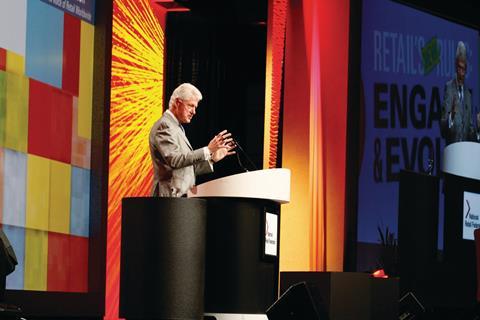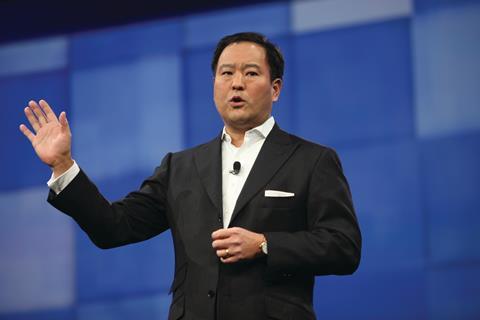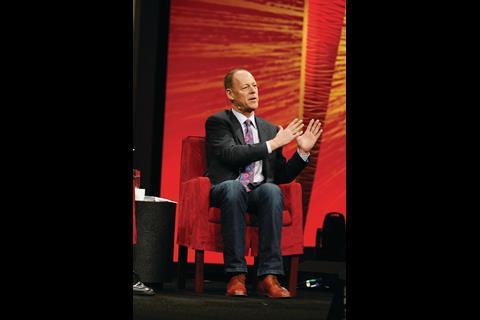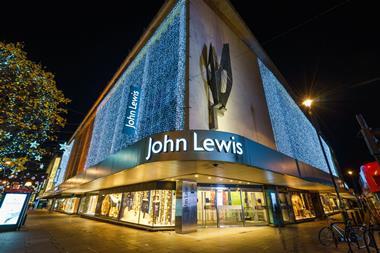2012 will be a key year for retailers, with spending constrained and structural changes hitting hard. Retailers at this year’s NRF conference showed they’re tackling the hurdles head on, finds Rebecca Thomson.
There’s no doubt that economic conditions are still tough in developed markets, and the focus for many retailers at the National Retail Federation (NRF) conference in New York had shifted slightly. Gone was the unwavering glare on new markets – instead, many are more occupied with getting current customers to spend more.
While international expansion is the answer for some, for others it’s not a logistical or financial possibility.
Instead, retailers are increasingly keen to encourage higher spend among their best customers through clever use of data, better brand building and by becoming an integral part of their lives.
As Macy’s chief marketing officer Peter Sachse said: “About seven out of 10 Americans shop with us already. We don’t need more customers, we need the customers we have to spend more money with us.”
And with so much happening in multichannel shopping there are plenty of options for engaging customers. NRF president Matthew Shay said: “The long-awaited convergence of in-store, mobile and online is happening in a big way. More than 70% of shoppers engage in multichannel shopping.”
Increasing spend
At the core of these trends is an acknowledgement that some of the highest profile retailers across the world from Apple to Tesco are using technology to inspire customers, boost loyalty and get them to spend more. Ultimately, retailers are looking for growth and international expansion is, of course, the answer for some. The biggest name at the conference – former US president Bill Clinton – was one of the few not to mention the changing nature of retail, instead talking about the crucial role that international markets will continue to play for developed economies like the US. “We have 4% of the world’s population, and 20% of the world economy. If we want to keep this we need to sell some stuff to someone else.” Shay agreed, saying overseas expansion was inevitable for many.
But, while the web has removed some barriers to foreign expansion, it’s still costly, it takes time, and it’s only an immediate option for the bigger retailers. Delegates from across the globe at NRF this year appeared keen to know how to develop their existing shoppers spend. Sachse said: “Focus on the customers you have – it takes between 12 and 20 new shoppers to make up for the loss of one highly loyal customer.”
It wasn’t so long ago that retail chief executives would have left IT to the experts. But with this new focus and the advent of disruptive technologies such as smartphones and social networks this is no longer possible, and nowhere was this more in evidence than on the main stages at the conference. Retail chiefs’ main topics of conversation were technology related, and even those areas that have traditionally been strictly IT-free zones are increasingly fuelled by technology. Every retail boss now needs to know how their business model is being affected – and how they will use technology to enable their company to evolve in the future. “My key focus is retail operations,” said Waitrose retail services director Graham Heald. “But part of my role is to bring solutions to life that help store managers. NRF brings retailers and IT teams together, which is really powerful.”
Data overload
At the heart of all this upheaval in retail is the changing consumer, and every retailer is feeling the need to keep up with this fast-paced shift in the demands of shoppers. “What customers want is changing so quickly,” said Heald. “We need to support that.”
Consumer technologies such as mobile phones and faster 3G networks are driving part of the change as shoppers adapt their habits in response to better access to product information. But it’s also the management of that information that’s causing retailers headaches.
IBM senior-vice president of marketing Jon Iwata said it’s not just the sheer volume of data that’s new, although the volume is certainly an issue. The speed of growth is also difficult to deal with – and the latest challenge is dealing with different types of data. From customers’ video product reviews to social network comments and a shopper’s online browsing history, the types of data potentially helpful to retailers are increasingly varied and complex.
“The amount of unstructured data from things like user-generated videos and social networks is estimated to grow by 500% over the next five years,” said Iwata. “We need new tools to deal with this – computing is being infused into the fabric of the world.”
This all requires different ways of working and changes to a company’s culture. Abercrombie & Fitch vice-president of ecommerce and cross-channel marketing Billy May said one main challenge for retailers was the relinquishing of control over the image of the company, and even the messages associated with it. May said: “Companies are so tightly controlled in their messaging and how they market. We have moved to the market of influence – how do you influence that dialogue and operate within it? That’s a dramatic change, especially for a company like Abercrombie & Fitch. We are very tightly controlled and there’s no easy answer.”
Learning to market to people effectively in an entirely new environment is not a simple task, and for Doug Mack, chief executive at US interiors etailer One Kings Lane, this means ecommerce today can be a little flat as a result. “More than a decade into ecommerce a lot of people would say it’s convenient, but not a lot of people would say it’s fun. We want to bring a fun factor into it.”
Jennifer Hyman, chief executive of US fashion site Rent the Runway, which hires out designer clothes, said developing an emotional connection with customers now is more important than ever. “Emotion is everything in our business,” she said. “We charge 90% off retail prices but when you survey our customers, price isn’t the reason they love our business. Emotion is how we build our relationship with them.”
Not only does an emotional connection with customers help a retailer make a sale, it also improves customer acquisitions as shoppers tell their friends, it boosts loyalty and it makes your business less dependent on price.
Shoppers also increasingly want to do business with companies they trust. Wholefoods co-chief executive Walter Robb said a key priority for his company was to be clear on what its values were and ensure it has a sense of purpose. “Having a purpose creates alignment and allows you to reach your aspiration,” he said. “Individuals have aspirations and so should companies. It allows you to fulfil your potential.”
Digital evolution
A handful of luxury fashion retailers have produced some of the cleverest uses of technology in brand building. Ralph Lauren executive vice-president of marketing and advertising David Lauren explained at the conference how the US fashion giant had developed its online marketing strategy. “Our brand is about conjuring up worlds you dream about,” he said. “Online you have an endless amount of space to create a story and sell products.”
The company bridged the offline and online worlds through initiatives such as the virtual stores it opened at the US Open tennis championships. “It was a chance to promote the internet and make people think differently,” Lauren said. “Most people see Ralph Lauren as a classic brand and we wanted them to think of us as modern. It was about enhancing the sense that the internet was not just a cheap place to get coupons but a place to build a luxury brand.” The company has tried everything from QR codes on adverts to featuring fashion editors of glossy magazines in its own videos.
Playing catch up
Burberry is another retailer often lauded for its successful use of digital technology in building its brand, becoming almost as much a media company as it is a designer. But Harrods Direct director David Worby warned many brands and retailers aren’t there yet. “Some luxury brands have been notoriously slow to adapt to the change we are experiencing because the commercial imperative for them isn’t as big as for others. So adapting a ‘house of brands’ brand like Harrods is a real challenge,” he said.
While retail is undoubtedly an industry in a constant state of flux, most agree that the period of change it’s going through at the moment is unusually challenging. But, as more retailers start to become clearer on their place in the new retailing environment, the pace of experimentation and innovation is picking up. That is just as well – as the industry continues to evolve and the economic recovery continues to be less than impressive, the industry’s reserves of entrepreneurial spirit will be sorely needed.
NRF WHAT YOU NEED TO KNOW
- International expansion was seen as inevitable for many retailers, although there was less discussion of the topic than in previous years. NRF president Matthew Shay pointed out that China’s retail sales rose 17% last year to a total of $2.7 trillion (£1.74 trillion) – it is now the biggest retail market in the world
- The economic environment in many developed markets remains tough, but the approach for some retailers has shifted. International markets are not the only answer – instead, many are focusing on how to get current customers to spend more
- It’s no longer only the technology companies and chief information officers concerned with systems, hardware and all things IT – retail bosses across the globe were keen to describe how integral technology has become to their business
- As this shift occurs, retailers’ internal cultures are changing to accommodate it. Technology suppliers, including NCR and SAP said they were increasingly dealing with chief executives or directors as well as chief information officers, and more retail bosses are becoming aware of the power of combining technical know-how with the needs of a retail business
- In a sluggish economy with cautious consumers, every retailer wants to connect with shoppers. Whether you rely on data or research to illuminate the role you play in customers’ lives, or whether you focus on connecting with them emotionally, standing out from the crowd has become imperative
- Multichannel continues to develop and the examples of clever retailing across the channels are growing. More businesses are providing cross-channel services and others are investing in back-office systems to enable further development































1 Reader's comment